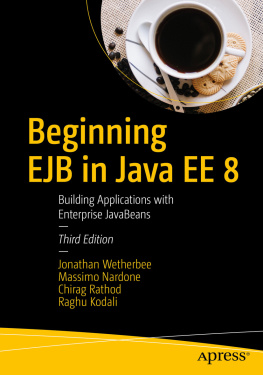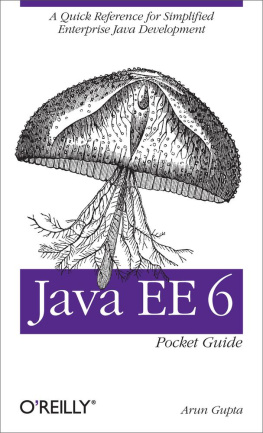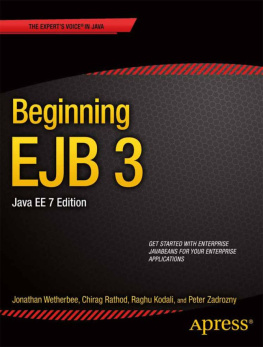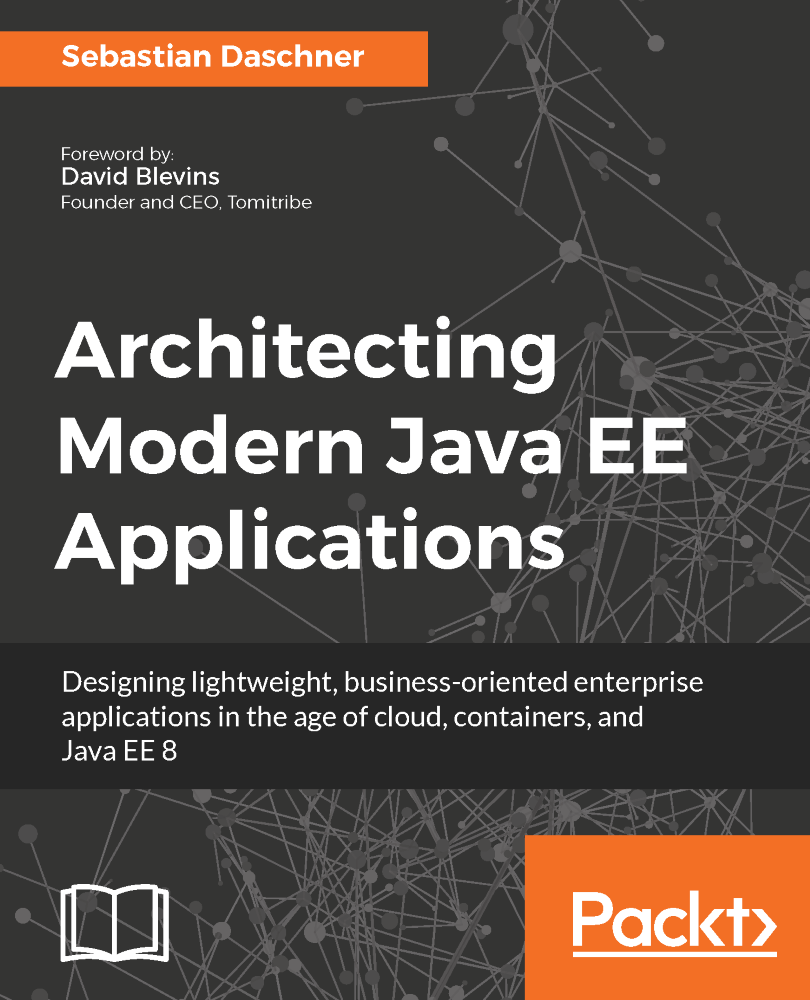
Architecting Modern Java EE Applications
Designing lightweight, business-oriented enterprise applications in the age of cloud, containers, and Java EE 8
Sebastian Daschner
BIRMINGHAM - MUMBAI
Architecting Modern Java EE Applications
Copyright 2017 Packt Publishing
All rights reserved. No part of this book may be reproduced, stored in a retrieval system, or transmitted in any form or by any means, without the prior written permission of the publisher, except in the case of brief quotations embedded in critical articles or reviews.
Every effort has been made in the preparation of this book to ensure the accuracy of the information presented. However, the information contained in this book is sold without warranty, either express or implied. Neither the author, nor Packt Publishing, and its dealers and distributors will be held liable for any damages caused or alleged to be caused directly or indirectly by this book.
Packt Publishing has endeavored to provide trademark information about all of the companies and products mentioned in this book by the appropriate use of capitals. However, Packt Publishing cannot guarantee the accuracy of this information.
First published: October 2017
Production reference: 1051017
Published by Packt Publishing Ltd.
Livery Place
35 Livery Street
Birmingham
B3 2PB, UK.
ISBN 978-1-78839-385-0
www.packtpub.com
Credits
Author Sebastian Daschner | Copy Editor Safis Editing |
Reviewer Melissa McKay | Project Coordinator Vaidehi Sawant |
Commissioning Editor Aaron Lazar | Proofreader Safis Editing |
Acquisition Editor Alok Dhuri | Indexer Aishwarya Gangawane |
Content Development Editor Rohit Kumar Singh | Graphics Abhinash Sahu |
Technical Editor Pavan Ramchandani | Production Coordinator Nilesh Mohite |
Foreword
Languages in our industry come and go, and the pace at which hip new languages come out only seems to increase. Every year, new languages come out and each has the colossal job of building an entire ecosystem around itself before the next new darling language comes and steals all the fickle early adopters. As each trend waxes and wanes, so do the ecosystems built around them.
Those of us who invest heavily in these trending ecosystems are often bitten by a common set of problems that lead to failures at the business level, losing project momentum due to the inability to find and hire developers. The new solutions presented are often the same old idea, but with a youthful misunderstanding of the problem space that leads to real performance and reliability problems. As the ecosystem matures, the act of recognizing and realigning to the true complexity of systems often results in severe incompatibilities. Tooling choices are often narrow or buggy, or they simply never materialize.
The unbeatable source of strength of the Java ecosystem over the last 20 years has been its standards, Java EE being chief among them. There have been 53 Java Specification Requests (JSRs) completed under the Java EE umbrella, ranging from XML parsing to JSON parsing, Servlets to JAX-RS, binary protocols to RESTful protocols, front-end technologies such as JSF or MVC, APIs for marshaling data to XML (JAX-B) or JSON (JSON-B) . The breadth of specifications is so wide that even if you do not think of yourself as a Java EE user, if you are a Java developer, you are definitely leveraging it in some way. With an estimate of 9 million Java developers worldwide, this is a stable and experienced talent pool.
Major deployments of Java EE range from Walmart, the world's largest retailer and third largest employer, to NASAs SOFIA program, scanning space at 40,000 feet. While the developer community is large and the corporations that use it are larger, the modern Java EE runtimes are incredibly small. Walmart and NASA, for example, use Apache TomEE, an implementation that is 35 MB on disk, boots in a second and consumes less that 30 MB of memory. This low profile is indicative of all modern implementations including WildFly, Payara, and LibertyProfile. The Java EE tools, cloud and IDE landscape is filled with competitive choices, almost too many to track. The 200+ person company ZeroTurnaround, for example, is built on a product that added instant deploy options to Java EE servers.
With such an expansive ecosystem that has almost 20 years of history, truly getting to the essence of what makes Java EE great today and how to put it into practice for todays Microservices world can be a challenge. Its all too easy to find very informed, but ultimately dated information from 2, 5, and 10 years back. The authoritative tone of one article one date can directly conflict with equally authoritative, but ultimately contrarian perspective of another author on a different year. In fact, a challenge almost unique to Java EE is its history. Few technologies last long enough and evolve so much.
This book, like the author himself, represents a new generation of Java EE. The chapters in this book guide the reader through the journey of leveraging Java EE in the context of todays Microservice and Containerized world. Less of a reference manual for API syntax, the perspectives and techniques in this book reflect real-world experience from someone who has recently gone through the journey themselves, meticulously annotated the obstacles, and has them ready to share. From packaging to testing to cloud usage, this book is an ideal companion to both new and more experienced developers who are looking for an earned insight bigger than an API to help them realign their thinking to architect modern applications in Java EE.
David Blevins
Founder and CEO, Tomitribe
About the Author
Sebastian Daschner is a Java freelancer working as a consultant and trainer and is enthusiastic about programming and Java (EE). He participates in the JCP, helping to form future Java EE standards, serving in the JSR 370 and 374 Expert Groups, and collaborating on various open source projects. For his contributions to the Java community and ecosystem, he was recognized with the titles Java Champion and Oracle Developer Champion.
Sebastian is a regular speaker at international IT conferences, such as JavaLand, JavaOne, and Jfokus. He won the JavaOne Rockstar award a t JavaOne 2016. Together with Java community manager, Steve Chin, he has traveled to dozens of conferences and Java User Groups on motorbike. Steve and Sebastian have launched JOnsen, a Java unconference held at a hot spring in the countryside of Japan.
Acknowledgments
There are many people whom I had the privilege to meet during my career, and who had a great impact not only on my work but also this book and without whom this would not have been possible. This list of people grows and grows every year. All of them are indirectly helped shaping this book, which I immensely appreciate.
Next page

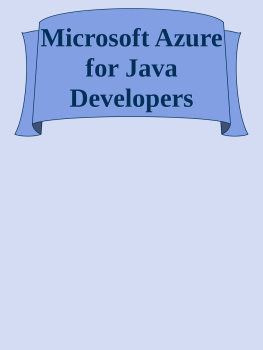

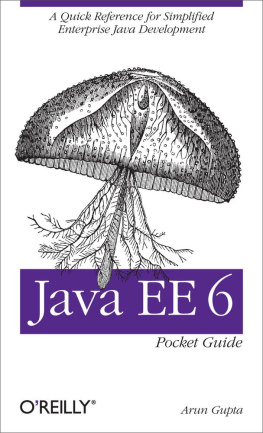

![Ken Finnigan [Ken Finnigan] - Enterprise Java Microservices](/uploads/posts/book/119364/thumbs/ken-finnigan-ken-finnigan-enterprise-java.jpg)
